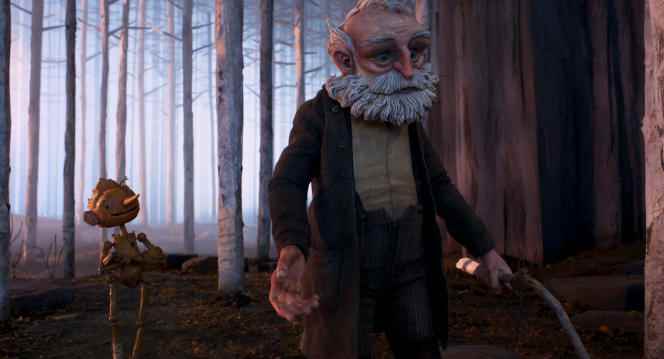You can do what you want with Pinocchio: after all, it’s just a piece of wood. The talking pine log from the imagination of Carlo Collodi (1826-1890) became a toy with rounded shapes in Walt Disney (1940), a real little boy, son of Nino Manfredi, in the adaptation of Luigi Comencini ( 1972), the protagonist of Erotic Adventures of Pinocchio (Corey Allen, 1971) and that of a horror movie (Pinocchio’s Revenge, Kevin Tenney, 1996). For the past two years, he has taken on the features of a child made up as a puppet in Matteo Garrone’s version and recomposed himself in cutesy pixels for Robert Zemeckis who worked for the Disney platform.
Why then take an interest in the new addition to this endless filmography rather than reread Collodi’s violent, poetic and sometimes incoherent text? Because Guillermo del Toro, who signs, with animator Mark Gustafson, the adaptation that Netflix puts online on December 9, found in the tribulations of the puppet something to feed his own obsessions, and that he made a a show that is both dark and gentle, a melancholic enchantment that evokes the days that are getting shorter and the trees that are bare more than the Christmas lights.
This Pinocchio-là comes to life on the screen through the grace of animation in stop-motion. The screenplay by Guillermo del Toro and Patrick McHale gives it a raison d’être not found in Collodi. Gepetto, an imposing old man, does not seek to fill his solitude but to come out of the mourning of his son who perished in a bombardment (we quickly understand that the story takes place not very far from the border between Italy and Austria -Hungary, shortly after the armistice of 1918). Present from the first sequence, death will never go away. As is customary when adapting this story, the author has rearranged the episodes, amended or transformed them.
Escape from totalitarianism
The life drive of Pinocchio, which nevertheless never loses its ligneous physiognomy, is irrepressible. It clashes with conventions, but also with the desire of its creator to keep it in limbo, very close to the missing son. Guillermo del Toro explains it in the note of intent that accompanies the film: for him, the Italian puppet is the cousin of Doctor Frankenstein’s creature, an artificial and deeply human being who struggles under the influence (here benevolent) of its creator.
We will find the puppet theater, directed by a terrifying incarnation of show business, but the island of children, the one where the dunces are changed into donkeys, here becomes an alpine fortress where the fascists prepare the boys for a military career. As in Pan’s Labyrinth, the Mexican filmmaker offers a childish character the help of the supernatural to escape the snares of totalitarianism. In Pinocchio, Mussolini took the place of Franco, and the blue fairy that of the magical creatures that populated the labyrinth. The beautiful lady of Walt Disney or Comencini (who had given the role to Gina Lollobrigida) gives way to a strange creature that could have come out of a canvas by Odilon Redon, with an unstable physiognomy.
You have 23.69% of this article left to read. The following is for subscribers only.
